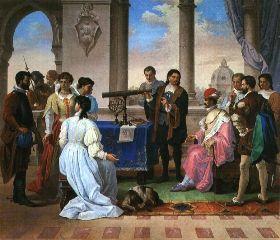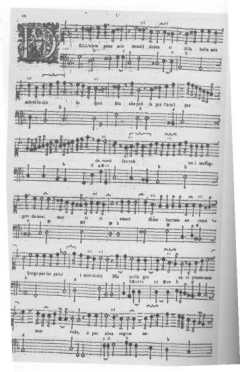Caccini – Amarilli Mia Bella
Caccini – Amarilli Mia Bella
You are my beloved and you must believe That I faithful to you.
Despite the long tones and minor mode, this song is not sad, but rather persuasive and reassuring.
Gulio Caccini – Amarilli Mia Bella
Caccini’s most important publication was Le nuove musiche of 1602, one of the earliest collections of solo songs. According to Caccini, the songs included were written from 1580 on. One in particular, “Amarilli mia bella,” is still well-known today. This famous song by Giulio Caccini was written on the cusp of the Baroque. This new style, the "seconda prattica", showed greater disparity between voices - no longer are all voices equally important.

Gulio Caccini, bust
Giulio Caccini was born in Rome on October 8, 1551. Little is known about Caccini’s early education, but in 1564, while still a boy, he sang soprano in the prestigious Cappella Giulia at St. Peter’s Basilica in Rome. Caccini was invited to Florence to perform at the wedding of Prince Francesco de’ Medici and Johanna of Austria. The celebration took place on December 18, 1565.

Medici court, Florence
Caccini was to stay in Florence for the rest of his life. He was a tenor singer employed by the Medici family who were the Dukes of Tuscany and famous patrons of art. Caccini was renowned for his singing and he accompanied himself on the archlute. His wife and children were also professional singers.

Gulio Caccini
Outside of the court, Caccini received support from other Florentine nobles. Chief among these was Giovanni de’ Bardi. Bardi formed the 'Camerata,' a group of musicians, theorists, and noblemen with intellectual interests who discussed such issues as the role of music in ancient Greek theater. Caccini later said that the discussions among the members of the Camerata had taught him more than had thirty years of studying counterpoint.

Le Nuove Musiche, first edition
The stile recitativo, as the newly created style of monody was called, proved to be popular not only in Florence, but elsewhere in Italy. Florence and Venice were the two most progressive musical centers in Europe at the end of the 16th century, and the combination of musical innovations from each place resulted in the development of what came to be known as the Baroque style. Caccini's achievement was to create a type of direct musical expression, as easily understood as speech, which later developed into the operatic recitative, and which influenced numerous other stylistic and textural elements in Baroque music.

Medici Palace, Florence
Caccini called “Amarilli” a madrigale, a through-composed piece with uneven phrase; he used aria to describe strophic songs composed in dance rhythms.
This delicate arioso is not as melodic as many contemporary works, but rather shows off the phrasing ability of the singer and the interplay between the voice and the accompaniment. The phrases are short, and generally quite discrete, each one for the most part building and subsiding to its own climax. The work has become a favorite with young singers, as the range is tiny but still provides a chance to show off control and phrasing.

Pagina from Le Nuove Musiche
In the last years of his life, Caccini published one more collection of songs (Nuove musiche de nuova maniera di scriverle, 1614). By 1617, he was in very poor health, and he died not long after revising his will on December 6, 1618.

Gulio Caccini
Amarilli, Italian text
Amarilli, mia bella
Non credi, o del mio cor dolce desio,
D'esser tu l'amor mio?
Credilo pur, e se timor t'assale,
Prendi questo mio strale,
Aprimi il petto e vedrai scritto in core:
Amarilli, Amarilli, Amarailli è il mio amore.
("Dubitar non ti vale" may be used as a more polite alternative to "Prendi questo mio strale")
Amarilli, English translation
Amarilli, lovely Amarilli Believest thee not, oh my heart's sweet desire tis thou my heart aspires? Believe, tis true: yet should a dread besiege thee doubt not, tis vane rip my bosom open, and there inscribed you'll see Amarilli, Amarilli, Amaraillys My sweetest love art thee








